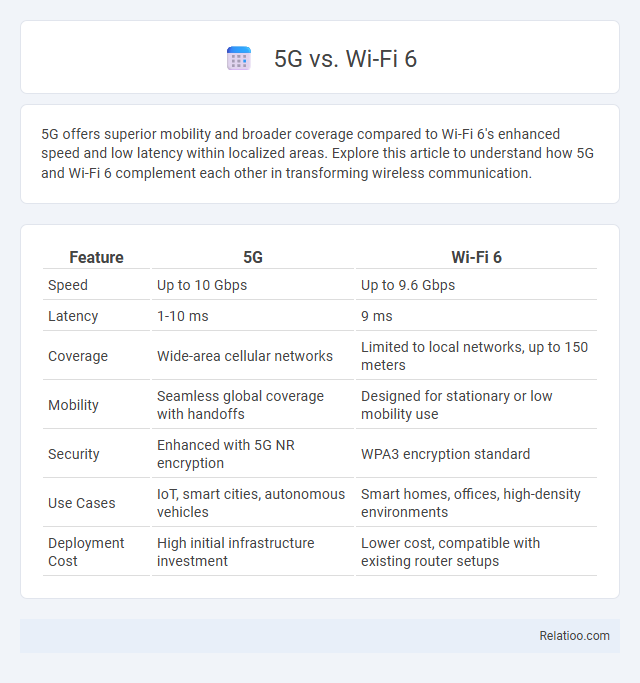5G offers superior mobility and broader coverage compared to Wi-Fi 6's enhanced speed and low latency within localized areas. Explore this article to understand how 5G and Wi-Fi 6 complement each other in transforming wireless communication.
Table of Comparison
| Feature | 5G | Wi-Fi 6 |
|---|---|---|
| Speed | Up to 10 Gbps | Up to 9.6 Gbps |
| Latency | 1-10 ms | 9 ms |
| Coverage | Wide-area cellular networks | Limited to local networks, up to 150 meters |
| Mobility | Seamless global coverage with handoffs | Designed for stationary or low mobility use |
| Security | Enhanced with 5G NR encryption | WPA3 encryption standard |
| Use Cases | IoT, smart cities, autonomous vehicles | Smart homes, offices, high-density environments |
| Deployment Cost | High initial infrastructure investment | Lower cost, compatible with existing router setups |
Introduction to 5G and Wi-Fi 6
5G and Wi-Fi 6 represent cutting-edge connectivity technologies designed to meet the demand for faster, more reliable wireless communication. 5G, the fifth generation of cellular networks, offers ultra-low latency and enhanced mobile broadband suitable for expansive outdoor coverage and IoT applications. Wi-Fi 6, the latest Wi-Fi standard, focuses on improved indoor wireless performance, higher data rates, and increased capacity, making your network experience seamless in dense environments.
Key Technologies Behind 5G and Wi-Fi 6
5G leverages advanced technologies like massive MIMO, beamforming, and millimeter-wave frequencies to deliver ultra-fast, low-latency mobile connectivity, optimizing performance for widespread, high-mobility use cases. Wi-Fi 6 incorporates OFDMA, MU-MIMO, and Target Wake Time to enhance efficiency, reduce congestion, and extend battery life in local wireless networks, making it ideal for dense environments and smart homes. Understanding these key technologies allows you to select the most suitable option for your connectivity needs, balancing speed, range, and device density.
Speed and Performance Comparison
5G offers ultra-low latency and high-speed connectivity, reaching up to 10 Gbps, making it ideal for mobile users requiring fast, reliable internet on the go. Wi-Fi 6 delivers exceptional speed improvements over its predecessor, with theoretical maximum speeds of 9.6 Gbps and better performance in dense environments, perfect for homes and offices. Choosing the right option depends on your need for mobility versus localized high throughput and network efficiency.
Coverage and Range Differences
5G technology offers extensive coverage with signals capable of spanning several kilometers, making it ideal for wide-area outdoor connectivity, while Wi-Fi 6 provides high-speed wireless access within limited indoor spaces typically up to 30 meters. Network range in 5G varies across frequency bands, with low-band 5G covering larger areas but slower speeds and mmWave 5G delivering faster speeds over shorter distances. Wi-Fi 6 excels in dense environments with improved capacity and reduced latency but lacks the broad geographic reach and mobility support inherent to 5G networks.
Latency: Real-Time Communication
5G offers ultra-low latency typically around 1 millisecond, making it ideal for real-time communication in mobile environments, while Wi-Fi 6 reduces latency to approximately 2-5 milliseconds, enhancing local network responsiveness. Your choice between 5G and Wi-Fi 6 depends on whether you need wide-area mobile coverage or high-speed, low-latency performance within a specific location. Network infrastructure plays a critical role in latency, as advanced 5G base stations and Wi-Fi 6 access points optimize real-time data transmission to support applications like gaming, VR, and video conferencing.
Security Features: 5G vs. Wi-Fi 6
5G offers robust security features such as enhanced encryption algorithms, improved authentication protocols, and network slicing to isolate user data, making it highly secure for mobile communications. Wi-Fi 6 strengthens security through WPA3, providing individualized encryption for each device and enhanced protection against password guessing attacks. Your choice between 5G and Wi-Fi 6 should consider these security advantages based on your specific network environment and threat model.
Use Cases for 5G
5G technology is ideal for use cases requiring ultra-low latency, high mobility, and massive device connectivity, such as autonomous vehicles, smart cities, and industrial IoT applications. Wi-Fi 6 excels in high-density environments like offices, stadiums, and homes, delivering enhanced speed and performance within localized areas. Networks leveraging 5G provide wide-area coverage with superior reliability for real-time applications demanding seamless communication over large distances, outperforming Wi-Fi 6's range and scalability limitations.
Use Cases for Wi-Fi 6
Wi-Fi 6 excels in high-density environments such as offices, stadiums, and airports by delivering faster speeds, lower latency, and improved capacity compared to previous Wi-Fi versions. It supports seamless connectivity for IoT devices, smart home automation, and enterprise applications where consistent performance and energy efficiency are critical. Unlike 5G, which is designed for wide-area mobility and cellular use cases, Wi-Fi 6 provides localized, high-throughput network access optimized for indoor and campus scenarios.
Cost and Deployment Considerations
5G networks require significant infrastructure investment, including cell towers and licensed spectrum, resulting in higher initial deployment costs compared to Wi-Fi 6, which leverages existing Ethernet backbones for more cost-effective installation in localized environments. Wi-Fi 6 offers lower operational expenses by using unlicensed spectrum and simpler hardware, making it ideal for indoor deployments such as offices and campuses. Network deployment costs for both depend on scale, but 5G suits wide-area public coverage with extensive infrastructure, while Wi-Fi 6 excels in high-density, short-range scenarios with easier scalability.
Future Outlook: 5G and Wi-Fi 6 Integration
The future of connectivity hinges on the seamless integration of 5G and Wi-Fi 6 technologies, enabling ultra-fast speeds and low latency for diverse applications. You can expect enhanced network efficiency, greater coverage, and improved user experiences across smart cities, IoT deployments, and enterprise environments. This convergence drives the evolution of hybrid networks that leverage the strengths of both 5G cellular and Wi-Fi 6, shaping the next generation of digital infrastructure.

Infographic: 5G vs Wi-Fi 6
 relatioo.com
relatioo.com